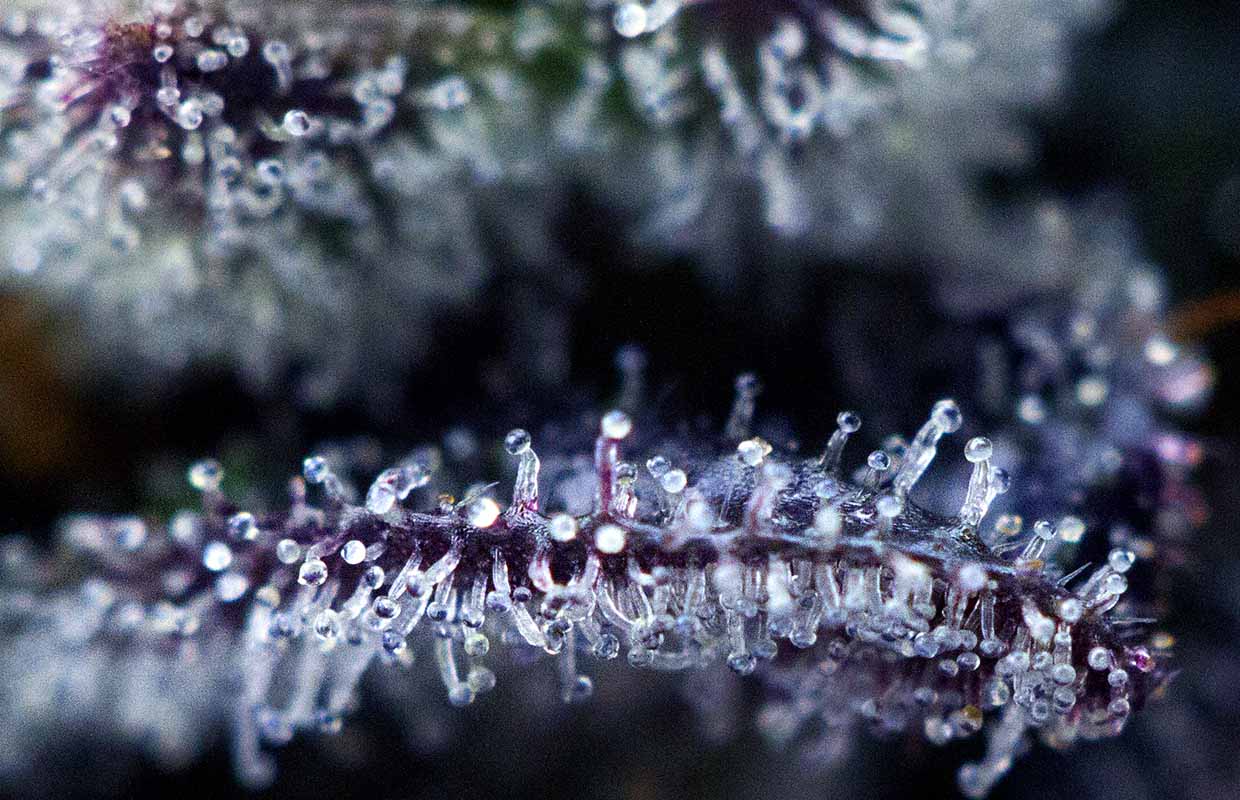Got Purps? Dialing In Cannabis’ Effects With Flavonoids
Flavonoids — the molecules that add to the color and flavor of the flower, among other things — are a treasure waiting to be unlocked.
In the modern day marijuana marketplace there is a dizzying array of strains to choose from, but luckily with testing methods surrounding the chemical make-up of our favorite flowers advancing just as rapidly as their development, smokers have more tools than ever before to find the strain that works best for them.
Working in conjunction with marijuana’s psychoactive component, THC, cannabis is made up of several different classes of molecules like cannabinoids — such as THC and CBD — as well as terpenes and “flavonoids.” The combination of these tiny natural molecules all contribute to a certain strain’s effects in what’s known as an “entourage effect.”
And, the flavonoids — the molecules that add to the color and flavor of the flower, among other things — are a treasure waiting to be unlocked. Early research shows they’re powerful anti-cancer agents, anti-inflammatories, anti-oxidants and anti-microbials. You could one day take medical cannabis to avoid the flu.
Raphael Mechoulam — the Israeli biochemist who determined the structure of CBD in 1963 and was the first to isolate THC a year later — told Cannabis Now that he sees promise in terms of the interaction between cannabinoids and terpenes (known for giving strains their signature scents). But he also noted that he was not aware of any current research on cannabinoids interactions with flavonoids.
“Very little study has been done on flavonoids and cannabis. In fact, we’re probably going to be one of the first labs to even offer flavonoid testing in cannabis anywhere in the world,” says Reggie Gaudino, vice president of scientific operations and director of intellectual property and genetic analysis at Steep Hill Labs.
Gaudino explains that flavonoids have very similar properties to terpenes as all compounds of marijuana branch out from a master scientific classification known as terpinoids. Flavonoids, he says, are essentially made up of terpene groupings and, in this way, like terpenes, they play a role in the flavor, scent and medicinal properties of certain strains. In addition, certain flavonoids have a role in the pigmentation of the plant.
“There’s one particular type of flavonoid that gives you the purple coloration, but flavonoids themselves really are more about flavor and odor,” Gaudino says. “The specific flavonoid that gives you pigment are the anthoxanthins or anthocyanins and while those do have some properties that have been shown to go along with these pigmentation colorations like the purples — the coloration alone is not what gives you those effects. It’s actually the chemical properties.”
To further unpack the idea, Gaudino explains that not only can flavonoids result in the deep purple hues of marijuana, they are also associated with additional benefits for the plant such as UV protection. While flavonoids are present in many different plants, the types unique to cannabis — cannaflavin A, B and C — have been shown to have exceptional medicinal benefits. A study published in the 1980s by Dr. Marilyn Barrett showed cannaflavin to be 30 times more potent than aspirin as an anti-inflammatory.
“The important thing about flavonoids is that many of them have some sort of medicinal or, if not medicinal, protective function,” Gaudino says. “So a lot of flavonoids are known to be anti-fungal or anti-bacterial. That’s why they help the plant and because of those things, by consuming them, they can help us as well as a natural anti-fungal or a natural anti-biotic.”
With advanced cannabis testing, the categorization of marijuana continues to grow in complexity to include flavonoids. Whereas cannabis was previously categorized as indica or sativa, now those in the scientific community are more apt to differentiate between narrow leaf drug types (sativas) and broad leaf drug types (indicas).
“OK, so sativas have narrow leaves and indicas have broad leaves, great, so why are we changing the names?” Gaudino says. “I’m not sure why, but what we do see is that it’s difficult to really go by a morphology because what we see now that we understand the genetics better is that some things, when they are grown under different conditions, can actually show a spectrum between narrow leaf and broad leaf.”
And as adventurous breeders continue to create new strains, scientists like Gaudino will simultaneously continue to hone their skills and techniques to classify and distinguish the properties of certain types of marijuana. Eventually, the hope is that by understanding the precise chemistry of a strain, users and doctors can select the most appropriate cannabis profile for the patient’s needs.
“I think ultimately we will have to categorize by chemical profile as opposed to morphology,” Gaudino says. “We keep what is really a picture that is limited by the resolution of what we can find, and so as the techniques improve and as the resolution gets finer we will be able to do a better group distinguishing and thus providing the right chemical profiling to be used as a medicine.”
Major Flavors
Flavonoids make tea, wine and chocolate taste divine. Research shows that the 21 known flavonoids in cannabis might help fight cancer, inflammation, diabetes, viral infections, as well as increase cerebral blood flow, and enhance cortical activity. Here are a few major flavors.
Apigenin — a powerful anti-anxiety agent; also found in chamomile; potent anti-inflammatory; cancer inhibitor
Silymarin — impedes replication of hepatitis C virus; anti-oxidant
Luteolin — potential cancer preventative and therapeutic
Queercetin — interrupts cancer cell creation cycle; anti-viral; potent anti-inflammatory
Kaempferol — anti-oxidant; diabetes treatment; heart disease treatment; anti-bacterial; anti-viral
Orientin — antioxidant, anti-inflammatory, antibiotic and anti-cancer agent
Vitexin — anti-cancer properties; could help treat gout
Source: McPartland, Russo, Fundacion CANNA
Originally published in issue 21 of Cannabis Now. LEARN MORE
TELL US, are you excited to learn about new ways cannabis can heal?





















